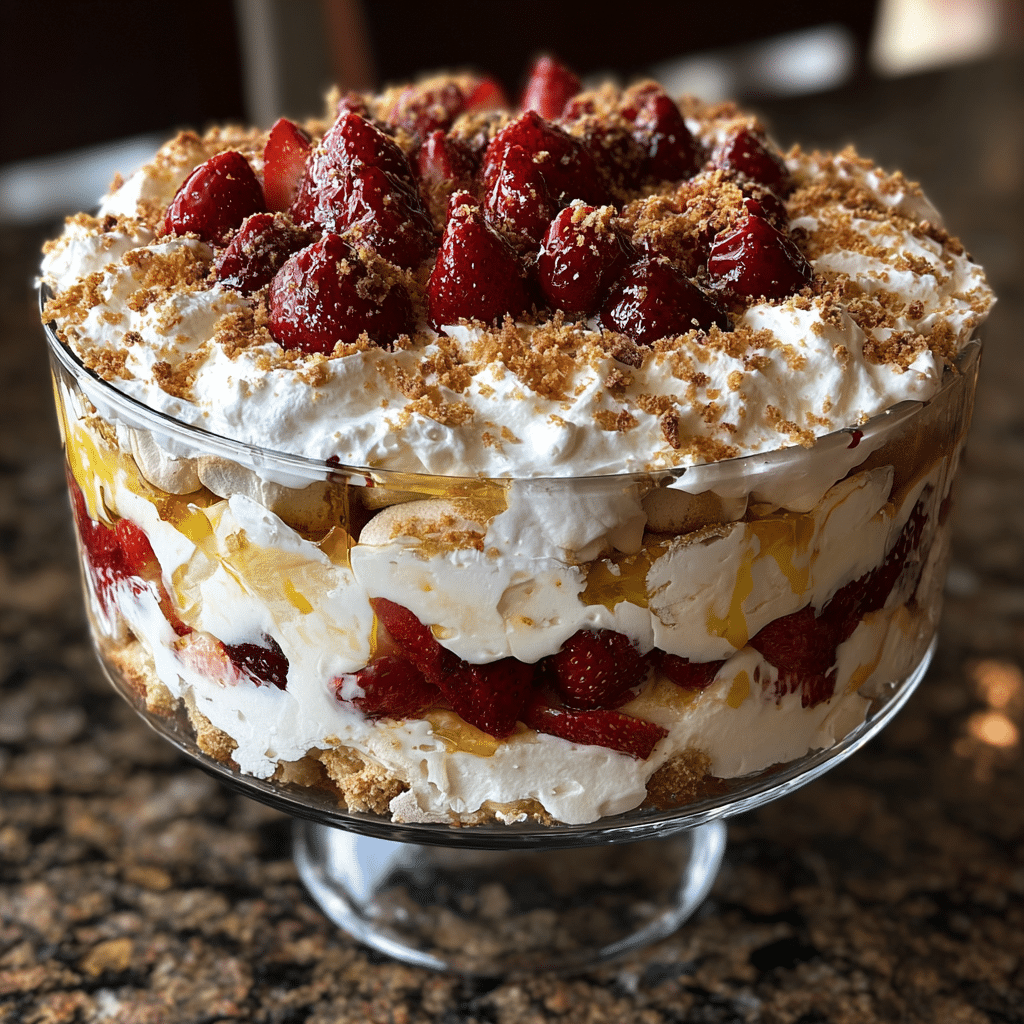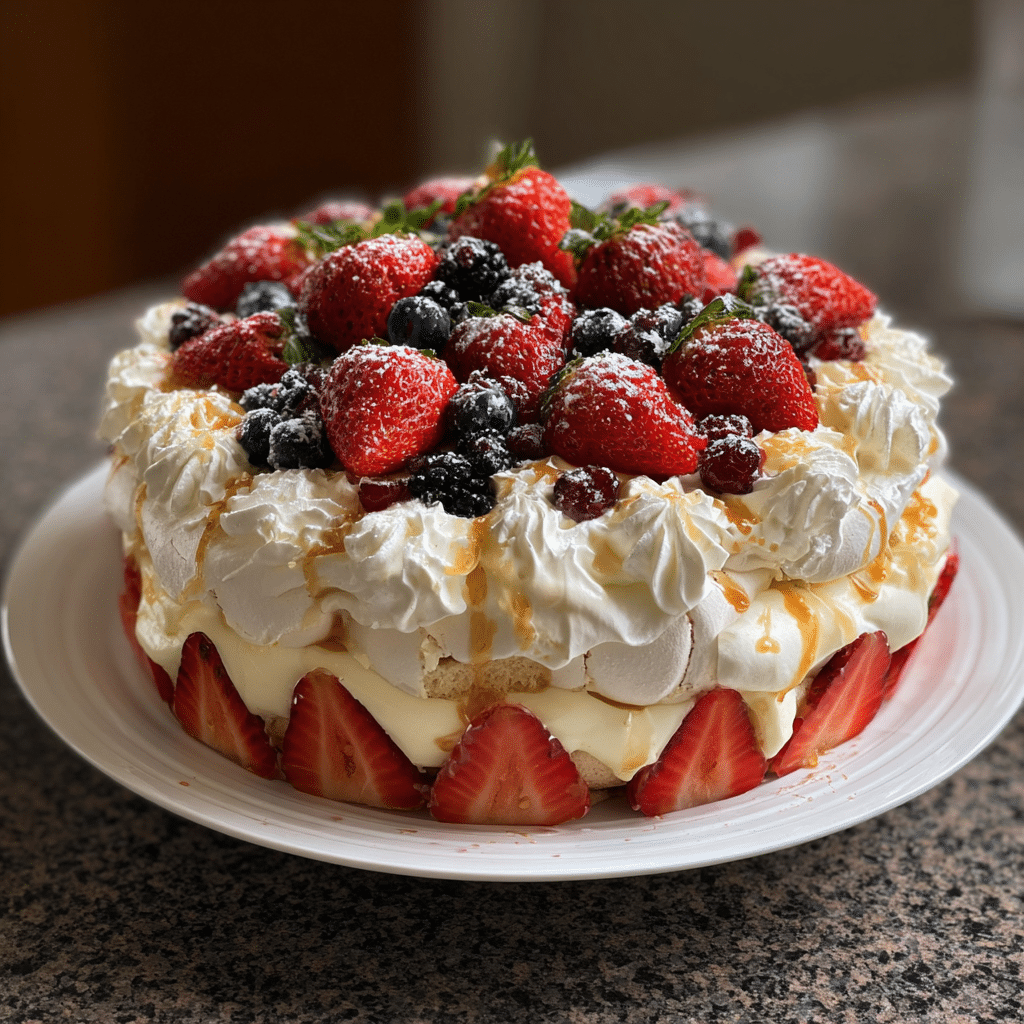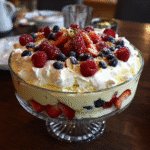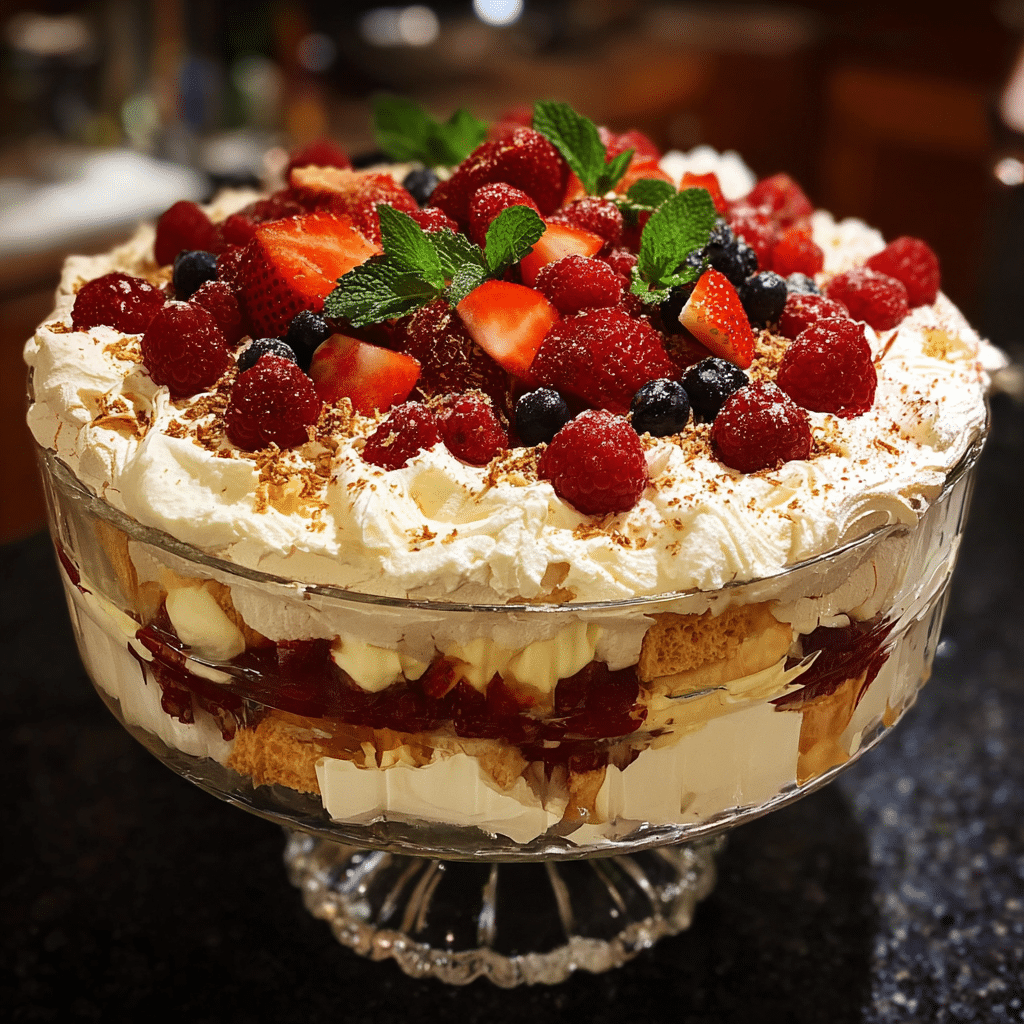This Pavlova recipe transforms the classic Australian meringue dessert into a show stopping Christmas trifle that will have your guests asking for seconds. Hi there! I’m Lisa, the heart and soul behind Recipesrealm, and I’m thrilled to share this festive masterpiece that’s become my signature holiday dessert. Are you tired of dense, heavy Christmas desserts that leave everyone feeling stuffed? Struggling to find an elegant dessert that looks as impressive as it tastes without spending hours in the kitchen?
This Christmas Pavlova Trifle promises layers of cloud-like meringue, luscious whipped cream, and vibrant fresh berries that create a dessert as beautiful as it is delicious. As someone who’s been perfecting recipes for years and hosting countless holiday gatherings, I’ve learned that the best festive desserts balance elegance with ease. This Pavlova recipe delivers that perfect combination it looks like it came from a fancy bakery but requires no advanced pastry skills.
In this comprehensive guide, you’ll discover why this Pavlova recipe works so brilliantly for holiday entertaining, how to create perfect crispy outside, marshmallow inside meringues, step-by-step assembly instructions that guarantee success, pro tips for avoiding common pitfalls, exciting flavor variations to customize your trifle, ideal serving suggestions that complement the season, and answers to all your burning questions about making this stunning dessert.
Why This Pavlova Recipe Works for Christmas
At Recipesrealm, we believe that food isn’t just about taste it’s about creating memories and sharing moments, and this Pavlova recipe embodies that holiday spirit perfectly. Here’s why this Christmas trifle has become a beloved tradition:
- Uses simple, accessible ingredients like egg whites, sugar, cream, and fresh berries no specialty items or exotic flavors required for this stunning Pavlova recipe
- Make-ahead friendly structure allows you to prepare components 1-2 days in advance, so you’re not stressed on Christmas Day with this convenient Pavlova recipe
- Perfect for holiday gatherings as this impressive Pavlova recipe serves 10-12 people generously and looks absolutely spectacular when presented in a glass trifle bowl
- Light and refreshing contrast to heavy holiday meals this Pavlova recipe provides a welcome break from rich, dense desserts without sacrificing indulgence
- Visually stunning presentation makes this Pavlova recipe the centerpiece of your dessert table with its beautiful red and green Christmas colors
- Dietary-friendly base since the meringue in this Pavlova recipe is naturally gluten-free, making it accessible to guests with wheat sensitivities
Choosing the Right Ingredients for Your Pavlova Recipe
The magic of a perfect Pavlova recipe lies in selecting quality ingredients and understanding how each component contributes to the final masterpiece.
Best Components for This Pavlova Recipe
The foundation of any great Pavlova recipe starts with fresh egg whites at room temperature cold eggs won’t whip to maximum volume. Choose extra-large or jumbo eggs for the most stable meringue structure. For sugar, superfine (caster) sugar dissolves most smoothly into the egg whites, creating that signature glossy finish in your Pavlova recipe. Regular granulated sugar works too, but you may need to beat it slightly longer.
For the cream component of this Pavlova recipe, heavy whipping cream with at least 36% fat content whips up beautifully and holds its shape throughout assembly and serving. Fresh berries are essential look for firm strawberries, plump blueberries, vibrant raspberries, and glossy blackberries that are in season. The contrast of tart fruit against sweet meringue is what makes this Pavlova recipe so irresistible.
Buying Tips for Your Pavlova Recipe
When shopping for ingredients for your Pavlova recipe, select eggs that are at least a week old rather than farm fresh slightly older egg whites whip to greater volume and create more stable meringues. Check berry containers carefully for any signs of mold or mushiness, and choose berries that are fragrant and deeply colored. For the best results in your Pavlova recipe, buy berries 1-2 days before serving when they’re at peak ripeness.
Choose pure vanilla extract over imitation for the cream layer in your Pavlova recipe—the quality really shines through in simple desserts like this. If using cream of tartar (which helps stabilize the meringue), make sure it’s fresh and not clumped, as old cream of tartar loses effectiveness in your Pavlova recipe.
Substitutions for Your Pavlova Recipe
This Pavlova recipe is wonderfully flexible. Swap fresh berries for tropical fruits like passion fruit, mango, and kiwi for a summer variation. Replace some of the whipped cream with Greek yogurt or mascarpone for added tanginess and richness in your Pavlova recipe. Use coconut cream instead of dairy cream for a vegan-friendly version (though the meringue contains eggs).
For the meringue base of your Pavlova recipe, white vinegar can substitute for lemon juice, and white granulated sugar can replace caster sugar if processed briefly in a food processor. Add festive flavors like peppermint extract, orange zest, or rosewater to customize your Pavlova recipe for different occasions.
Ingredients & Prep for Your Pavlova Recipe

Essential Ingredient List for This Pavlova Recipe
For the Meringue Layers:
- 6 large egg whites, at room temperature
- 1 1/2 cups superfine (caster) sugar
- 1 1/2 teaspoons white vinegar
- 1 1/2 teaspoons cornstarch
- 1 teaspoon pure vanilla extract
- Pinch of salt
For the Cream Filling:
- 3 cups heavy whipping cream, cold
- 1/3 cup powdered sugar
- 2 teaspoons pure vanilla extract
- 1/4 cup mascarpone cheese (optional, for extra richness)
For the Berry Layer:
- 2 cups fresh strawberries, hulled and sliced
- 1 cup fresh blueberries
- 1 cup fresh raspberries
- 1/2 cup fresh blackberries
- 2 tablespoons granulated sugar (to macerate berries)
- Zest of 1 orange
For Garnish:
- Fresh mint leaves
- Pomegranate arils
- Powdered sugar for dusting
- Additional whole berries
Prep Work for Your Pavlova Recipe
Begin your Pavlova recipe by bringing egg whites to room temperature this takes about 30 minutes and is crucial for maximum volume. Ensure your mixing bowl and whisk attachment are completely clean and grease-free, as even a tiny bit of fat will prevent egg whites from whipping properly. Line two large baking sheets with parchment paper and trace three 7-inch circles on each sheet (you’ll make 6 thin meringue layers for this Pavlova recipe).
Prepare your berries by washing and thoroughly drying them, then slicing strawberries and combining all berries in a bowl with sugar and orange zest. Let them macerate for 20-30 minutes while you prepare other components of your Pavlova recipe this draws out natural juices and creates a beautiful syrup. Sift your cornstarch to remove any lumps before beginning the meringue for your Pavlova recipe.
Meringue Mixing Technique for Your Pavlova Recipe
In the bowl of a stand mixer fitted with the whisk attachment, beat egg whites and salt on medium speed until foamy, about 1-2 minutes. Gradually add superfine sugar one tablespoon at a time while beating continuously this slow addition is critical for dissolving sugar completely in your Pavlova recipe. Once all sugar is incorporated, increase speed to high and beat for 8-10 minutes until stiff, glossy peaks form and the mixture feels smooth when rubbed between your fingers (no sugar grains).
In the final minute of beating, add vinegar, cornstarch, and vanilla extract to your Pavlova recipe mixture. These ingredients create that perfect texture contrast—crispy exterior with a marshmallowy center. The meringue should be so stiff that you can turn the bowl upside down without it moving. Don’t underbeat, as loose meringue will spread too much during baking and ruin your Pavlova recipe.
Step-by-Step Cooking Instructions for Your Pavlova Recipe

Pre-Cooking Prep for Your Pavlova Recipe
Preheat your oven to 225°F (110°C) low and slow is essential for this Pavlova recipe. If your oven runs hot, reduce to 200°F. Place your prepared parchment-lined baking sheets on middle and lower racks. Have a large spoon or piping bag fitted with a large round tip ready for shaping the meringue layers of your Pavlova recipe. Work efficiently once the meringue is ready, as it doesn’t wait.
Ensure your kitchen isn’t too humid, as moisture is the enemy of crisp meringue in any Pavlova recipe. If it’s a particularly humid day, consider making the meringue components another time, or run a dehumidifier in your kitchen. Room temperature should ideally be between 65-72°F for best results with your Pavlova recipe.
Baking Method for Your Pavlova Recipe
Divide the meringue mixture into six equal portions (about 3/4 cup each). Spread each portion within the traced circles on your parchment paper, creating disks about 1/2-inch thick with slightly raised edges these will hold the cream and berries in your assembled Pavlova recipe. Use the back of a spoon to create subtle swirls on the surface for visual interest.
Place both baking sheets in the preheated oven and bake for 60-75 minutes until the meringues are dry to the touch and lift easily from the parchment. The color of your Pavlova recipe meringues should remain pale cream, not brown. Turn off the oven and crack the door open slightly, allowing the meringues to cool completely inside the oven for at least 2 hours or overnight. This gradual cooling prevents cracking and creates the perfect texture for your Pavlova recipe.
Cream Preparation for Your Pavlova Recipe
In a large, chilled mixing bowl, combine cold heavy cream, powdered sugar, and vanilla extract. Beat on medium speed until soft peaks form, then increase to medium-high and beat until stiff peaks form about 3-4 minutes total. Be careful not to overbeat, or you’ll end up with butter instead of cream for your Pavlova recipe. If using mascarpone, gently fold it into the whipped cream at the soft peak stage for extra richness.
The cream should hold its shape firmly but still spread smoothly. Refrigerate until ready to assemble your Pavlova recipe whipped cream can be made up to 4 hours in advance if stored covered in the refrigerator. Give it a gentle whisk before using if it has separated slightly.
Assembly for Your Pavlova Recipe
Choose a large glass trifle bowl (3-4 quart capacity) for the most stunning presentation of your Pavlova recipe. Place the first meringue layer at the bottom, breaking it into large, irregular pieces if needed to fit. Spread about 1/2 cup of whipped cream over the meringue, then add a layer of macerated berries with some of their juice. Repeat this layering process meringue, cream, berries until all six meringue layers are used, ending with a generous dollop of whipped cream on top.
For the final flourish of your Pavlova recipe, arrange whole fresh berries artistically on top, scatter pomegranate arils for jewel-like sparkle, tuck in fresh mint leaves, and dust lightly with powdered sugar. The assembled trifle can be refrigerated for up to 2 hours before serving any longer and the meringue will begin to soften (though many people love that slightly chewy texture in a Pavlova recipe).
Pro Tips for Perfect Pavlova Recipe Success
Avoiding Common Pavlova Recipe Mistakes
The most common issue when making any Pavlova recipe is weeping meringue (liquid pooling under the meringue). Prevent this by ensuring sugar is completely dissolved before baking test by rubbing a small amount between your fingers. Add cornstarch and vinegar, which stabilize the meringue structure in your Pavlova recipe. Another frequent problem is cracked meringue, which happens when oven temperature is too high or cooling is too rapid. Always bake low and slow, and cool gradually inside the turned-off oven for the best results with your Pavlova recipe.
If your meringue spreads too much during baking, your egg whites weren’t beaten stiffly enough. Make sure peaks stand straight up when you lift the whisk. Beige or brown meringues indicate oven temperature was too high for your Pavlova recipe—invest in an oven thermometer to ensure accuracy, as many home ovens run 25-50°F hotter than the dial indicates.
Tool Recommendations for Your Pavlova Recipe
A stand mixer makes this Pavlova recipe significantly easier, as you need to beat egg whites for 8-10 minutes that’s exhausting by hand. A handheld electric mixer works too but requires more patience. Use a copper or glass bowl for beating egg whites rather than plastic, which can retain grease. A flexible silicone spatula helps fold in final ingredients without deflating your meringue for this Pavlova recipe.
Invest in quality parchment paper rather than wax paper (which can smoke in the oven) or silicone mats (which can cause spreading). A large glass trifle bowl (3-4 quart capacity) shows off the beautiful layers of your Pavlova recipe. Individual serving glasses work wonderfully for a deconstructed version of this Pavlova recipe at formal dinner parties.
Storage & Make-Ahead Tips for Your Pavlova Recipe
The genius of this Pavlova recipe is that components can be prepared in advance. Bake meringue layers up to 3 days ahead and store in an airtight container at room temperature with parchment paper between layers do not refrigerate, as humidity will make them sticky. Whip cream up to 4 hours ahead and refrigerate covered. Macerate berries 2-3 hours before assembly and keep refrigerated.
Assemble the complete Pavlova recipe no more than 2 hours before serving for the best texture contrast between crispy meringue and creamy filling. If you prefer a softer, marshmallow-like texture throughout, assemble 4-6 hours ahead—the meringue will absorb moisture and become wonderfully chewy. Leftover assembled trifle keeps refrigerated for 1-2 days, though the meringue will continue softening (still delicious, just different texture).
Flavor Variations for Your Pavlova Recipe
Festive Holiday Twists on Your Pavlova Recipe
Transform your classic Pavlova recipe with these seasonal variations. For Chocolate Peppermint Pavlova, add 3 tablespoons cocoa powder to the meringue mixture, fold crushed peppermint candies into the whipped cream, and garnish with chocolate shavings. Create Gingerbread Spice Pavlova by adding 1 teaspoon ground ginger, 1/2 teaspoon cinnamon, and 1/4 teaspoon nutmeg to the meringue, then layer with spiced cream and caramelized pears in your festive Pavlova recipe.
Try Cranberry Orange Pavlova by folding orange zest into the meringue, making cranberry compote for the fruit layer, and garnishing with candied orange slices. For Eggnog Pavlova, flavor the whipped cream with nutmeg and a splash of maple syrup, layer with sugared cranberries, and dust with freshly grated nutmeg for a holiday-inspired Pavlova recipe that tastes like Christmas in every bite.
International Pavlova Recipe Variations
Give your Pavlova recipe global flair with these inspired variations. Tropical Paradise Pavlova features passion fruit pulp folded into the cream, layers of mango, pineapple, and kiwi, and a garnish of toasted coconut flakes. French Lavender Pavlova incorporates culinary lavender into the meringue, pairs with honey-sweetened cream and fresh figs, and provides an elegant, sophisticated twist on the classic Pavlova recipe.
Create Italian Tiramisu Pavlova by brushing meringue layers with espresso, folding mascarpone into the cream, dusting with cocoa powder, and garnishing with chocolate-covered espresso beans. Middle Eastern Rose Pavlova adds rosewater to the cream, layers with pistachios and pomegranate arils, drizzles with honey, and offers an exotic take on the traditional Pavlova recipe.
Dietary-Adapted Pavlova Recipe Options
Making your Pavlova recipe accessible to various dietary needs is simpler than you think. For Sugar-Free Pavlova, replace sugar with erythritol or monk fruit sweetener in both meringue and cream (use powdered versions for best dissolving). For Dairy-Free Pavlova, substitute coconut cream for heavy cream chill a can of full-fat coconut milk overnight, scoop out the solid cream, and whip with powdered sugar (the meringue is already dairy-free in any Pavlova recipe).
While traditional Pavlova recipe meringue requires eggs, you can create Vegan Aquafaba Pavlova using the liquid from canned chickpeas use 3/4 cup aquafaba in place of egg whites, add 1/4 teaspoon cream of tartar, and beat for 15-20 minutes until stiff peaks form. The technique is identical to regular meringue in this innovative Pavlova recipe adaptation.
Pavlova Recipe Variations Comparison Table
| Variation | Key Flavor Addition | Fruit Pairing | Best Season | Special Feature |
|---|---|---|---|---|
| Classic Christmas | Vanilla, orange zest | Mixed berries | Winter | Traditional, crowd-pleasing |
| Chocolate Peppermint | Cocoa, peppermint | Raspberries, cherries | Winter holidays | Rich, festive |
| Tropical Paradise | Passion fruit, coconut | Mango, pineapple, kiwi | Summer | Bright, refreshing |
| Lemon Curd | Lemon zest in meringue | Blueberries, lemon curd | Spring/Summer | Tangy, elegant |
| Caramel Apple | Cinnamon in meringue | Caramelized apples | Fall | Cozy, warming |
| Strawberry Shortcake | Vanilla bean | Fresh strawberries | Spring/Summer | Classic American |
| Tiramisu-Inspired | Espresso, cocoa | Mascarpone, no fruit | Year-round | Sophisticated |
| Rose Pistachio | Rosewater | Raspberries, pistachios | Spring | Middle Eastern flair |
Serving Suggestions for Your Pavlova Recipe
Your Pavlova recipe deserves to be presented beautifully and paired thoughtfully with complementary elements. Serve this trifle as the grand finale to your Christmas dinner, bringing it to the table with fanfare and letting guests admire the stunning layers before scooping generous portions. The visual impact is part of the experience the contrast of white cream, red berries, and green mint creates perfect holiday colors that need no additional decoration.
Pair this Pavlova recipe with a dessert beverage that enhances without overwhelming the delicate flavors. Champagne or sparkling Prosecco cuts through the sweetness beautifully and adds celebration to the moment. Sweet Moscato complements the berry flavors perfectly, while late-harvest Riesling provides honeyed notes that harmonize with the meringue in your Pavlova recipe. For non-drinkers, serve with vanilla-spiced tea, peppermint hot chocolate, or sparkling cranberry juice.
For a stunning dessert spread, surround your Pavlova recipe trifle with complementary treats. Offer small portions of shortbread cookies for textural contrast, set out a plate of chocolate truffles for guests who want extra richness, and provide fresh fruit platters for those who prefer lighter options. The beauty of this Pavlova recipe is its versatility—it works equally well as a standalone showstopper or as part of a larger dessert buffet.
Consider portion control when serving this Pavlova recipe it’s richer than it appears, and a little goes a long way. Use a large serving spoon to scoop through all the layers, ensuring each guest gets meringue, cream, and berries in every bite. Serve in wide, shallow bowls or dessert plates rather than deep bowls, which allows the beautiful layers to be visible even after plating your Pavlova recipe.
FAQs About This Pavlova Recipe
Can I make the meringue for this Pavlova recipe ahead of time?
Absolutely! One of the best features of any Pavlova recipe is that meringue components can be made up to 3 days in advance. Store the completely cooled meringue layers in an airtight container at room temperature with parchment paper between each layer. Never refrigerate unbaked or baked meringue, as the humidity will make them sticky and weepy. Keep them in a cool, dry place until ready to assemble your Pavlova recipe.
Why did my Pavlova recipe meringue crack during baking?
Cracking in a Pavlova recipe typically occurs from oven temperature being too high or cooling too quickly. Ensure your oven temperature is accurate using an oven thermometer many ovens run hot. Always cool meringue gradually inside the turned-off oven with the door cracked open. Some surface cracks are actually normal and traditional for pavlova meringues, adding rustic charm. Major structural cracks can be hidden with cream and fruit when assembling your Pavlova recipe trifle.
How do I know when the meringue in my Pavlova recipe is done baking?
The meringue in your Pavlova recipe is ready when it’s dry to the touch on the outside, lifts easily from the parchment paper, and sounds hollow when tapped gently on the bottom. The color should remain pale cream or ivory if it’s browning, your oven temperature is too high. The inside should still be slightly soft and marshmallow-like, not completely dried through. After 60-75 minutes at 225°F, turn off the oven and let the meringue cool completely inside for perfect results with your Pavlova recipe.
Can I use frozen berries in this Pavlova recipe?
Fresh berries work best for this Pavlova recipe due to their firm texture and bright appearance, but frozen berries can work in a pinch. If using frozen, thaw them completely and drain excess liquid thoroughly frozen berries release significantly more juice than fresh, which can make your trifle soggy. Consider making a cooked berry compote with frozen fruit instead of using them raw in your Pavlova recipe. Reserve the prettiest fresh berries for the top garnish even if using frozen for the interior layers.
Is this Pavlova recipe safe for pregnant women?
Traditional Pavlova recipe meringue is fully cooked during the baking process, reaching temperatures that eliminate any food safety concerns with raw eggs. The meringue bakes at 225°F for over an hour, which is well above the 160°F temperature needed to kill salmonella. However, if you have concerns, you can use pasteurized egg whites (available in cartons) in your Pavlova recipe for complete peace of mind. The whipped cream should be made with pasteurized dairy products, which is standard for commercial cream.
Why is my Pavlova recipe meringue chewy instead of crispy?
Chewy meringue in a Pavlova recipe usually results from humidity either during baking, cooling, or storage. Make meringue on a dry day if possible, and store baked meringue in an airtight container. Some chewiness is actually traditional for pavlova (unlike French meringues which are crispy throughout), so a marshmallow center with crispy exterior is perfect. If it’s chewy all the way through, it may need additional baking time or your oven temperature may be too low for this Pavlova recipe.
Can I make individual servings of this Pavlova recipe?
Yes! This Pavlova recipe adapts beautifully to individual presentations. Pipe or spoon meringue into 3-inch circles, making 18-24 small disks. Bake for 45-50 minutes instead of 60-75 minutes. Layer in individual glasses use 3 small meringue pieces per serving with cream and berries between each layer. This approach is perfect for formal dinner parties and eliminates the need for scooping and serving your Pavlova recipe at the table.
How far in advance can I assemble this Pavlova recipe?
For the crispest texture contrast, assemble your Pavlova recipe no more than 2 hours before serving. However, many people prefer the softer, chewy texture that develops when the trifle sits for 4-6 hours as the meringue absorbs moisture from the cream and fruit. It’s personal preference crispy and dramatic versus soft and integrated. The assembled Pavlova recipe will keep refrigerated for up to 2 days, though the meringue will become increasingly soft (still delicious, just different).
Conclusion
Gather your loved ones and create this stunning Christmas Pavlova Trifle tonight it’s time to make memories around a dessert that’s as beautiful as it is delicious! From cozy family dinners to vibrant holiday gatherings, this Pavlova recipe is crafted to make every celebration feel like a special occasion. Whether you’re an experienced home cook or just getting started with impressive desserts, this step-by-step guide ensures your success.
If you found this recipe helpful, we encourage you to share it with your network or save it for future use.
We’d be delighted to see your unique creations feel free to share your photos with us pinterest
Print
Pavlova Recipe 8 Steps to Stunning Christmas Trifle Perfection
- Total Time: 185
- Yield: 10–12 servings 1x
Description
This Christmas Pavlova Trifle combines crispy meringue layers, billowy whipped cream, and fresh berries in a stunning holiday dessert. Light, elegant, and make-ahead friendly—perfect for impressing guests!
Ingredients
**For the Meringue Layers:**
6 large egg whites, at room temperature
1 1/2 cups superfine (caster) sugar
1 1/2 teaspoons white vinegar
1 1/2 teaspoons cornstarch
1 teaspoon pure vanilla extract
Pinch of salt
**For the Cream Filling:**
3 cups heavy whipping cream, cold
1/3 cup powdered sugar
2 teaspoons pure vanilla extract
1/4 cup mascarpone cheese (optional)
**For the Berry Layer:**
2 cups fresh strawberries, hulled and sliced
1 cup fresh blueberries
1 cup fresh raspberries
1/2 cup fresh blackberries
2 tablespoons granulated sugar
Zest of 1 orange
**For Garnish:**
Fresh mint leaves
Pomegranate arils
Powdered sugar for dusting
Additional whole berries
Instructions
1. Preheat oven to 225°F (110°C). Line two baking sheets with parchment paper and trace three 7-inch circles on each sheet.
2. In a stand mixer, beat egg whites and salt on medium speed until foamy (1-2 minutes). Gradually add sugar one tablespoon at a time while beating continuously.
3. Increase speed to high and beat for 8-10 minutes until stiff, glossy peaks form and mixture feels smooth with no sugar grains.
4. Add vinegar, cornstarch, and vanilla in the final minute of beating until fully incorporated.
5. Divide meringue into six equal portions. Spread each portion within traced circles, creating 1/2-inch thick disks with slightly raised edges.
6. Bake for 60-75 minutes until meringues are dry to the touch and lift easily from parchment. Turn off oven, crack door open, and let cool completely inside for 2+ hours.
7. Prepare berries: Combine all berries with sugar and orange zest. Let macerate for 20-30 minutes.
8. Make whipped cream: Beat cold heavy cream, powdered sugar, and vanilla until stiff peaks form (3-4 minutes). Fold in mascarpone if using.
9. Assemble trifle: In a large glass trifle bowl, layer meringue pieces (broken to fit), whipped cream, and macerated berries. Repeat until all six meringue layers are used.
10. Top with final dollop of cream, arrange whole berries, scatter pomegranate arils, add mint leaves, and dust with powdered sugar. Refrigerate up to 2 hours before serving.
Notes
Meringue layers can be made up to 3 days ahead and stored in an airtight container at room temperature.
Ensure mixing bowl and whisk are completely grease-free for proper meringue volume.
Don’t refrigerate unbaked or baked meringue—humidity makes them sticky.
Sugar must be completely dissolved before baking—test by rubbing between fingers.
Cool meringue gradually in turned-off oven to prevent cracking.
For crispest texture, assemble no more than 2 hours before serving.
For softer, chewier texture, assemble 4-6 hours ahead.
Leftover trifle keeps refrigerated for 1-2 days (meringue will soften).
Use pasteurized egg whites if concerned about food safety.
Recipe is naturally gluten-free.
- Prep Time: 40
- Cook Time: 75
- Category: Dessert
- Method: Baking
- Cuisine: Australian/New Zealand
Nutrition
- Serving Size: 1 cup (approximately)
- Calories: 285
- Sugar: 38g
- Sodium: 65mg
- Fat: 14g
- Saturated Fat: 9g
- Unsaturated Fat: 4g
- Trans Fat: 0g
- Carbohydrates: 42g
- Fiber: 2g
- Protein: 3g
- Cholesterol: 52mg
Keywords: pavlova recipe, Christmas trifle, meringue dessert, holiday dessert, festive pavlova, berry trifle, gluten-free dessert

